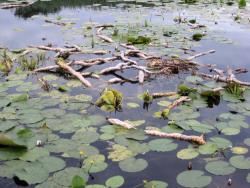Perennial, rhizomes stout, horizontal, branching freely, deeply rooted. Leaves spiral, ex-stipulate; petioles terete to elliptical, plano-convex, winged, or trigonous with small air canals; lamina with primary venation pinnate and non-anastomosing lateral veins, emergent (not NZ), floating, or submerged, leaf-bases deeply cordate. Flowers subglobose, perianth hypogynous; outer tepals 4–7 petaloid (often persistent on fruit); inner tepals many, small and staminoid with abaxial nectaries, no transitions between tepals and stamens; flowers protogynous, diurnal opening. Stamens laminar, strap-like, yellow or red-tinged; anther dehiscence extrorse; pollen monocolpate, tectum imperforate, exine surface echinate. Ovary syncarpus, superior; carpels 4–36, sessile stigmatic rays on a hard-flattened disk, stigmatic tissue with secretary 1-celled papillae. Fruit follicle-like, coriaceous, maturation emergent, dehiscent. Seeds exarillate, numerous.
Species of Nuphar have subglobose-shaped yellow flowers (sometimes reddish tinged) and very distinctive, greenish, urceolate-shaped fruit capped by a hard-flattish disk that matures above the water surface, in contrast to species of Nymphaea where the fruits mature below the water surface.
Eleven species in temperate regions of the northern hemisphere: Eurasia, South East Asia, north Africa, North America as far south as Cuba and north-east Mexico. A conspicuous component of the northern hemisphere freshwater flora (Padgett et al. 1999).
| Category | Number |
|---|---|
| Exotic: Fully Naturalised | 1 |
| Total | 1 |
All species are 2n = 34 (Padgett 2007).
Nuphar is a northern hemisphere temperate genus (Padgett 2007) and the only genus in Nymphaeaceae with no tropical species. Features characterising the genus are a superior ovary, abaxial tepal nectaries, echinate pollen, and emergent fruit maturation. The group is divided into Old World/New World lineages (with one exception) based on molecular analyses and morphology (Padgett et al. 1999, 2007). The Old World Section Nuphar is characterised by flowers with five outer tepals, fruits with walls slightly furrowed, with elongated necks and narrow, stigmatic discs. The New World Section Astylus has flowers with more outer tepals (up to 14), fruits with walls deeply furrowed, lacking necks and with broader discs. All species have been recorded as self-compatible and protogynous, entomophilous with floral scents (Ervik et al. 1995). Although seeds have no aril as in Nymphaea, the slim pericarp has air-bubbles and serves the same. Recently well-preserved fossil seeds close to Nuphar described as Notonuphar (Fries 2017) have been recorded from the Eocene of the Antarctic Peninsula, the first record of Nymphaeales from Antarctica.




